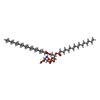+Search query
-Structure paper
| Title | Full-Length P2X Structures Reveal How Palmitoylation Prevents Channel Desensitization. |
|---|---|
| Journal, issue, pages | Cell, Vol. 179, Issue 3, Page 659-670.e13, Year 2019 |
| Publish date | Oct 17, 2019 |
 Authors Authors | Alanna E McCarthy / Craig Yoshioka / Steven E Mansoor /  |
| PubMed Abstract | P2X receptors are trimeric, non-selective cation channels activated by extracellular ATP. The P2X receptor subtype is a pharmacological target because of involvement in apoptotic, inflammatory, and ...P2X receptors are trimeric, non-selective cation channels activated by extracellular ATP. The P2X receptor subtype is a pharmacological target because of involvement in apoptotic, inflammatory, and tumor progression pathways. It is the most structurally and functionally distinct P2X subtype, containing a unique cytoplasmic domain critical for the receptor to initiate apoptosis and not undergo desensitization. However, lack of structural information about the cytoplasmic domain has hindered understanding of the molecular mechanisms underlying these processes. We report cryoelectron microscopy structures of full-length rat P2X receptor in apo and ATP-bound states. These structures reveal how one cytoplasmic element, the C-cys anchor, prevents desensitization by anchoring the pore-lining helix to the membrane with palmitoyl groups. They show a second cytoplasmic element with a unique fold, the cytoplasmic ballast, which unexpectedly contains a zinc ion complex and a guanosine nucleotide binding site. Our structures provide first insights into the architecture and function of a P2X receptor cytoplasmic domain. |
 External links External links |  Cell / Cell /  PubMed:31587896 / PubMed:31587896 /  PubMed Central PubMed Central |
| Methods | EM (single particle) |
| Resolution | 2.9 - 3.3 Å |
| Structure data | EMDB-20702: EMDB: Cryo electron microscopy map of the ATP-gated rat P2X7 ion channel in the apo, closed state EMDB-20703: Cryo electron microscopy map of the ATP-gated rat P2X7 ion channel in the ATP-bound, open state |
| Chemicals |  ChemComp-GDP:  ChemComp-ZN:  ChemComp-NAG:  ChemComp-Q3G:  ChemComp-PLM:  ChemComp-ATP: |
| Source |
|
 Keywords Keywords | MEMBRANE PROTEIN / Ion Channel Apoptosis |
 Movie
Movie Controller
Controller Structure viewers
Structure viewers About Yorodumi Papers
About Yorodumi Papers








